Deck 14: The Brain and Cranial Nerves
Question
Question
Question
Question
Question
Question
Question
Question
Question
Question
Question
Question
Question
Question
Question
Question
Question
Question
Question
Question
Question
Question
Question
Question
Question
Question
Question
Question
Question
Question
Question
Question
Question
Question
Question
Question
Question
Question
Question
Question
Question
Question
Question
Question
Question
Question
Question
Question
Question
Question
Question
Question
Question
Question
Question
Question
Question
Question
Question
Question
Question
Question
Question
Question
Question
Question
Question
Question
Question
Question
Question
Question
Question
Question
Question

Unlock Deck
Sign up to unlock the cards in this deck!
Unlock Deck
Unlock Deck
1/75
Play
Full screen (f)
Deck 14: The Brain and Cranial Nerves
1
Which region of the brain contains the inferior olivary nucleus?
A)Pons
B)Medulla oblongata
C)Pyramids
D)Hypothalamus
E)Midbrain
A)Pons
B)Medulla oblongata
C)Pyramids
D)Hypothalamus
E)Midbrain
B
2
Cerebrospinal fluid carries small amounts of chemicals like glucose from the _____ to neurons and neuroglia.
A)interstitial fluid
B)bile
C)intracellular fluid
D)arachnoid space
E)blood
A)interstitial fluid
B)bile
C)intracellular fluid
D)arachnoid space
E)blood
E
3
Which of the following is a narrow fluid-filled cavity found along the midline superior to the hypothalamus and between the right and left halves of the thalamus?
A)Lateral ventricle
B)Septum pellucidum
C)Third ventricle
D)Fourth ventricle
E)Fifth ventricle
A)Lateral ventricle
B)Septum pellucidum
C)Third ventricle
D)Fourth ventricle
E)Fifth ventricle
C
4
Which of the following brain structures consists of the medulla oblongata,pons and midbrain?
A)Brain stem
B)Cerebrum
C)Cerebellum
D)Diencephalon
E)Dura mater
A)Brain stem
B)Cerebrum
C)Cerebellum
D)Diencephalon
E)Dura mater

Unlock Deck
Unlock for access to all 75 flashcards in this deck.
Unlock Deck
k this deck
5
Which brain structure is responsible for the "startle reflex" in response to loud sounds?
A)Superior colliculus
B)Inferior colliculus
C)Pontine nucleus
D)Medial lemniscus
E)Arbor vitae
A)Superior colliculus
B)Inferior colliculus
C)Pontine nucleus
D)Medial lemniscus
E)Arbor vitae

Unlock Deck
Unlock for access to all 75 flashcards in this deck.
Unlock Deck
k this deck
6
Which of the following disorders is the most common brain disorder?
A)Transient ischemic attack
B)Alzheimer's disease
C)Cerebrovascular accident
D)Brain tumor
E)Attention deficit hyperactivity disorder
A)Transient ischemic attack
B)Alzheimer's disease
C)Cerebrovascular accident
D)Brain tumor
E)Attention deficit hyperactivity disorder

Unlock Deck
Unlock for access to all 75 flashcards in this deck.
Unlock Deck
k this deck
7
Which of the following are networks of capillaries that produce cerebrospinal fluid and are found in the walls of the ventricles of the brain?
A)Choroid plexuses
B)Lateral apertures
C)Interventricular foramina
D)Brachial plexuses
E)Aqueduct of the midbrain
A)Choroid plexuses
B)Lateral apertures
C)Interventricular foramina
D)Brachial plexuses
E)Aqueduct of the midbrain

Unlock Deck
Unlock for access to all 75 flashcards in this deck.
Unlock Deck
k this deck
8
Which region of the brain contains the pontine respiratory group and apneustic areas that help control respiration?
A)Spinal cord
B)Midbrain
C)Pons
D)Thalamus
E)Cerebellum
A)Spinal cord
B)Midbrain
C)Pons
D)Thalamus
E)Cerebellum

Unlock Deck
Unlock for access to all 75 flashcards in this deck.
Unlock Deck
k this deck
9
Which of the following is a fluid-filled cavity located in each hemisphere of the cerebrum?
A)Lateral ventricle
B)Septum pellucidum
C)Fourth ventricle
D)Third ventricle
E)Corpus callosum
A)Lateral ventricle
B)Septum pellucidum
C)Fourth ventricle
D)Third ventricle
E)Corpus callosum

Unlock Deck
Unlock for access to all 75 flashcards in this deck.
Unlock Deck
k this deck
10
Which fingerlike projections found in the dural venous sinuses reabsorb cerebrospinal fluid?
A)Choroid plexuses
B)Microvilli
C)Arachnoid villi
D)Dural villi
E)Lemnisci
A)Choroid plexuses
B)Microvilli
C)Arachnoid villi
D)Dural villi
E)Lemnisci

Unlock Deck
Unlock for access to all 75 flashcards in this deck.
Unlock Deck
k this deck
11
Which of the following brain structures consists of the thalamus,hypothalamus and epithalamus?
A)Cerebellum
B)Brain stem
C)Cerebrum
D)Diencephalon
E)Dura mater
A)Cerebellum
B)Brain stem
C)Cerebrum
D)Diencephalon
E)Dura mater

Unlock Deck
Unlock for access to all 75 flashcards in this deck.
Unlock Deck
k this deck
12
Which brain vesicle gives rise to the midbrain and cerebral aqueduct?
A)Prosencephalon
B)Mesencephalon
C)Rhombencephalon
D)Telencephalon
E)Myelencephalon
A)Prosencephalon
B)Mesencephalon
C)Rhombencephalon
D)Telencephalon
E)Myelencephalon

Unlock Deck
Unlock for access to all 75 flashcards in this deck.
Unlock Deck
k this deck
13
Which extension of the dura mater separates the two hemispheres of the cerebrum?
A)Falx cerebri
B)Falx cerebelli
C)Tentorium cerebelli
D)Tentorium cerebri
E)None of these choices
A)Falx cerebri
B)Falx cerebelli
C)Tentorium cerebelli
D)Tentorium cerebri
E)None of these choices

Unlock Deck
Unlock for access to all 75 flashcards in this deck.
Unlock Deck
k this deck
14
Which of the following structures protect the brain by preventing the movement of harmful substances and pathogens from the blood into the brain tissue?
A)Dura mater
B)Arachnoid mater
C)Cerebrospinal fluid
D)Blood brain barrier
E)All of these choices
A)Dura mater
B)Arachnoid mater
C)Cerebrospinal fluid
D)Blood brain barrier
E)All of these choices

Unlock Deck
Unlock for access to all 75 flashcards in this deck.
Unlock Deck
k this deck
15
Which of the following is NOT a major region of the brain?
A)Brain stem
B)Cerebellum
C)Cauda equina
D)Diencephalon
E)Cerebrum
A)Brain stem
B)Cerebellum
C)Cauda equina
D)Diencephalon
E)Cerebrum

Unlock Deck
Unlock for access to all 75 flashcards in this deck.
Unlock Deck
k this deck
16
Which of the following describes a function of cerebrospinal fluid?
1)Mechanical protection
2)pH homeostasis
3)Circulation
A)1 only
B)2 only
C)3 only
D)Both 1 and 2
E)All of these choices
1)Mechanical protection
2)pH homeostasis
3)Circulation
A)1 only
B)2 only
C)3 only
D)Both 1 and 2
E)All of these choices

Unlock Deck
Unlock for access to all 75 flashcards in this deck.
Unlock Deck
k this deck
17
Which of the following is a branch of the trigeminal (V)nerve?
A)Opthalmic nerve
B)Maxillary nerve
C)Mandibular nerve
D)All of these are branches of the trigeminal (V)nerve
E)None of these are branches of the trigeminal (V)nerve
A)Opthalmic nerve
B)Maxillary nerve
C)Mandibular nerve
D)All of these are branches of the trigeminal (V)nerve
E)None of these are branches of the trigeminal (V)nerve

Unlock Deck
Unlock for access to all 75 flashcards in this deck.
Unlock Deck
k this deck
18
Pyramids are
A)gray matter protrusions found on the medulla oblongata.
B)white matter protrusions found on the medulla oblongata.
C)gray matter protrusions found on the pons.
D)white matter protrusions found on the pons.
E)a network of white and gray matter found in the medulla oblongata.
A)gray matter protrusions found on the medulla oblongata.
B)white matter protrusions found on the medulla oblongata.
C)gray matter protrusions found on the pons.
D)white matter protrusions found on the pons.
E)a network of white and gray matter found in the medulla oblongata.

Unlock Deck
Unlock for access to all 75 flashcards in this deck.
Unlock Deck
k this deck
19
The brain and spinal cord develop from the _____ neural tube.
A)mesodermal
B)endodermal
C)ectodermal
D)cranial
E)caudal
A)mesodermal
B)endodermal
C)ectodermal
D)cranial
E)caudal

Unlock Deck
Unlock for access to all 75 flashcards in this deck.
Unlock Deck
k this deck
20
Which of the following meninges has two layers?
A)Spinal dura mater
B)Cranial dura mater
C)Spinal arachnoid mater
D)Cranial arachnoid mater
E)All of these choices
A)Spinal dura mater
B)Cranial dura mater
C)Spinal arachnoid mater
D)Cranial arachnoid mater
E)All of these choices

Unlock Deck
Unlock for access to all 75 flashcards in this deck.
Unlock Deck
k this deck
21
Cranial nerve V is also known as the _____ nerve.
A)trochlear
B)oculomotor
C)trigeminal
D)vagus
E)abducens
A)trochlear
B)oculomotor
C)trigeminal
D)vagus
E)abducens

Unlock Deck
Unlock for access to all 75 flashcards in this deck.
Unlock Deck
k this deck
22
Which portion of the cerebellum contributes to equilibrium and balance?
A)Tentorium cerebelli
B)Anterior lobe
C)Posterior lobe
D)Flocculonodular lobe
E)Transverse fissure
A)Tentorium cerebelli
B)Anterior lobe
C)Posterior lobe
D)Flocculonodular lobe
E)Transverse fissure

Unlock Deck
Unlock for access to all 75 flashcards in this deck.
Unlock Deck
k this deck
23
Which of the following structures conducts nerve impulses between the two different hemispheres of the cerebrum?
A)Association tracts
B)Corpus callosum
C)Projection tracts
D)Pyramids
E)Sulci
A)Association tracts
B)Corpus callosum
C)Projection tracts
D)Pyramids
E)Sulci

Unlock Deck
Unlock for access to all 75 flashcards in this deck.
Unlock Deck
k this deck
24
The cerebellar cortex consists of folia,which are
A)parallel folds of white matter.
B)found in the vermis only.
C)portions of the pyramids.
D)parallel folds of gray matter.
E)used in the RAS system.
A)parallel folds of white matter.
B)found in the vermis only.
C)portions of the pyramids.
D)parallel folds of gray matter.
E)used in the RAS system.

Unlock Deck
Unlock for access to all 75 flashcards in this deck.
Unlock Deck
k this deck
25
Which region of the brain contains the pineal gland?
A)Thalamus
B)Cerebellum
C)Hypothalamus
D)Cerebrum
E)Epithalalmus
A)Thalamus
B)Cerebellum
C)Hypothalamus
D)Cerebrum
E)Epithalalmus

Unlock Deck
Unlock for access to all 75 flashcards in this deck.
Unlock Deck
k this deck
26
Which region of the brain serves as the major relay station for most sensory impulses that reach the primary sensory areas of the cerebral cortex from the spinal cord and brain stem?
A)Thalamus
B)Hypothalamus
C)Epithalamus
D)Pons
E)Midbrain
A)Thalamus
B)Hypothalamus
C)Epithalamus
D)Pons
E)Midbrain

Unlock Deck
Unlock for access to all 75 flashcards in this deck.
Unlock Deck
k this deck
27
Which of the following functional areas of the cerebrum is responsible for speech?
A)Broca's area
B)Primary gustatory area
C)Common integrative area
D)Prefrontal cortex area
E)Primary somatosensory area
A)Broca's area
B)Primary gustatory area
C)Common integrative area
D)Prefrontal cortex area
E)Primary somatosensory area

Unlock Deck
Unlock for access to all 75 flashcards in this deck.
Unlock Deck
k this deck
28
Which of the following functional areas of the cerebrum is responsible for sensing body touch and temperature?
A)Broca's area
B)Primary visual area
C)Common integrative area
D)Prefrontal cortex area
E)Primary somatosensory area
A)Broca's area
B)Primary visual area
C)Common integrative area
D)Prefrontal cortex area
E)Primary somatosensory area

Unlock Deck
Unlock for access to all 75 flashcards in this deck.
Unlock Deck
k this deck
29
Which structure carries sensory information coming from proprioceptors found in the trunk and limbs into the cerebellum?
A)Inferior cerebellar peduncle
B)Middle cerebellar peduncle
C)Superior cerebellar peduncle
D)Anterior lobe
E)Posterior lobe
A)Inferior cerebellar peduncle
B)Middle cerebellar peduncle
C)Superior cerebellar peduncle
D)Anterior lobe
E)Posterior lobe

Unlock Deck
Unlock for access to all 75 flashcards in this deck.
Unlock Deck
k this deck
30
During brain development,the gyri of the cerebrum are formed because
A)the white matter enlarges faster than the overlying gray matter.
B)the cerebrum grows faster than the dura mater.
C)the hypothalamus is larger than the epithalamus.
D)the gray matter grows faster than the underlying white matter.
E)the lobes of the cerebrum are not symmetrical.
A)the white matter enlarges faster than the overlying gray matter.
B)the cerebrum grows faster than the dura mater.
C)the hypothalamus is larger than the epithalamus.
D)the gray matter grows faster than the underlying white matter.
E)the lobes of the cerebrum are not symmetrical.

Unlock Deck
Unlock for access to all 75 flashcards in this deck.
Unlock Deck
k this deck
31
Which of the following functional areas of the cerebrum is responsible for conscious movements of the body?
A)Broca's area
B)Primary visual area
C)Somatosensory association area
D)Primary motor area
E)Primary somatosensory area
A)Broca's area
B)Primary visual area
C)Somatosensory association area
D)Primary motor area
E)Primary somatosensory area

Unlock Deck
Unlock for access to all 75 flashcards in this deck.
Unlock Deck
k this deck
32
Which of the following is a nucleus found in the midbrain that releases dopamine?
A)Substantia nigra
B)Inferior olivary nucleus
C)Inferior colliculus
D)Cerebral peduncle
E)pontine nucleus
A)Substantia nigra
B)Inferior olivary nucleus
C)Inferior colliculus
D)Cerebral peduncle
E)pontine nucleus

Unlock Deck
Unlock for access to all 75 flashcards in this deck.
Unlock Deck
k this deck
33
Which of the following is a nucleus found in the medulla oblongata that receives sensory information associated with touch,pressure and vibration?
A)Tectum
B)Superior colliculus
C)Substantia nigra
D)Pontine nucleus
E)Gracile nucleus
A)Tectum
B)Superior colliculus
C)Substantia nigra
D)Pontine nucleus
E)Gracile nucleus

Unlock Deck
Unlock for access to all 75 flashcards in this deck.
Unlock Deck
k this deck
34
Together the lentiform and caudate nuclei are known as the
A)globus pallidus.
B)putamen.
C)medial geniculate nucleus.
D)corpus striatum.
E)internal capsule.
A)globus pallidus.
B)putamen.
C)medial geniculate nucleus.
D)corpus striatum.
E)internal capsule.

Unlock Deck
Unlock for access to all 75 flashcards in this deck.
Unlock Deck
k this deck
35
Which of the following are NOT controlled by the hypothalamus?
A)Hunger
B)Thirst
C)Blood calcium concentration
D)Emotional behavior
E)Body temperature
A)Hunger
B)Thirst
C)Blood calcium concentration
D)Emotional behavior
E)Body temperature

Unlock Deck
Unlock for access to all 75 flashcards in this deck.
Unlock Deck
k this deck
36
Which of the following cranial nerves carries sensory information coming from the nasal cavity to the olfactory area of the cerebrum?
A)olfactory (I)nerve (cranial nerve I)
B)trigeminal (V)nerve (cranial nerve V)
C)abducens (VI)nerve (cranial nerve VI)
D)vestibulocochlear (VIII)nerve (cranial nerve VIII)
E)vagus (X)nerve (cranial nerve X)
A)olfactory (I)nerve (cranial nerve I)
B)trigeminal (V)nerve (cranial nerve V)
C)abducens (VI)nerve (cranial nerve VI)
D)vestibulocochlear (VIII)nerve (cranial nerve VIII)
E)vagus (X)nerve (cranial nerve X)

Unlock Deck
Unlock for access to all 75 flashcards in this deck.
Unlock Deck
k this deck
37
Which of the following cranial nerves is responsible for regulating visceral activity?
A)Oculomotor
B)Trigeminal
C)Spinal accessory
D)Facial
E)Vagus
A)Oculomotor
B)Trigeminal
C)Spinal accessory
D)Facial
E)Vagus

Unlock Deck
Unlock for access to all 75 flashcards in this deck.
Unlock Deck
k this deck
38
Which of the following cranial nerves control movements of the eyeball?
A)optic (II)nerve,oculomotor (III)nerve,and trochlear (IV)nerve
B)olfactory (I)nerve,trigeminal (V)nerve,and vagus (X)nerve
C)oculomotor (III)nerve,glossopharyngeal (IX)nerve,and trigeminal (V)nerve
D)oculomotor (III)nerve,trochlear (IV)nerve,and abducens (VI)nerve
E)vagus (X)nerve,accessory (XI)nerve,and hypoglossal (XII)nerve
A)optic (II)nerve,oculomotor (III)nerve,and trochlear (IV)nerve
B)olfactory (I)nerve,trigeminal (V)nerve,and vagus (X)nerve
C)oculomotor (III)nerve,glossopharyngeal (IX)nerve,and trigeminal (V)nerve
D)oculomotor (III)nerve,trochlear (IV)nerve,and abducens (VI)nerve
E)vagus (X)nerve,accessory (XI)nerve,and hypoglossal (XII)nerve

Unlock Deck
Unlock for access to all 75 flashcards in this deck.
Unlock Deck
k this deck
39
Which of the following glands is directly controlled by hormones produced by the hypothalamus?
A)Posterior pituitary gland
B)Anterior pituitary gland
C)Thymus gland
D)Pancreas
E)Pineal gland
A)Posterior pituitary gland
B)Anterior pituitary gland
C)Thymus gland
D)Pancreas
E)Pineal gland

Unlock Deck
Unlock for access to all 75 flashcards in this deck.
Unlock Deck
k this deck
40
Which of the following functional areas of the cerebrum is responsible for vision?
A)Broca's area
B)Primary visual area
C)Common integrative area
D)Primary olfactory area
E)Primary somatosensory area
A)Broca's area
B)Primary visual area
C)Common integrative area
D)Primary olfactory area
E)Primary somatosensory area

Unlock Deck
Unlock for access to all 75 flashcards in this deck.
Unlock Deck
k this deck
41
Which cranial nerve in the diagram causes heart rate to decrease?
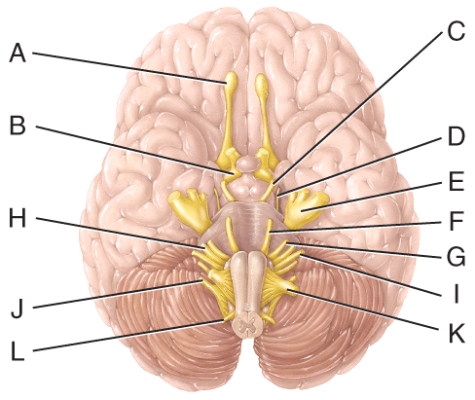
A)H
B)I
C)J
D)K
E)L

A)H
B)I
C)J
D)K
E)L

Unlock Deck
Unlock for access to all 75 flashcards in this deck.
Unlock Deck
k this deck
42
Which cranial nerve in the diagram innervates the lateral rectus muscle?
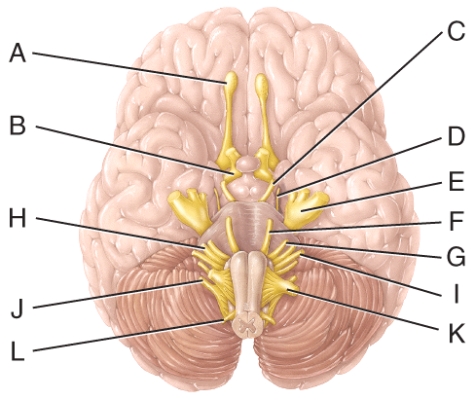
A)B
B)C
C)D
D)E
E)F

A)B
B)C
C)D
D)E
E)F

Unlock Deck
Unlock for access to all 75 flashcards in this deck.
Unlock Deck
k this deck
43
Which cranial nerve in the diagram has an autonomic motor function primarily involved in stimulating secretion of saliva?
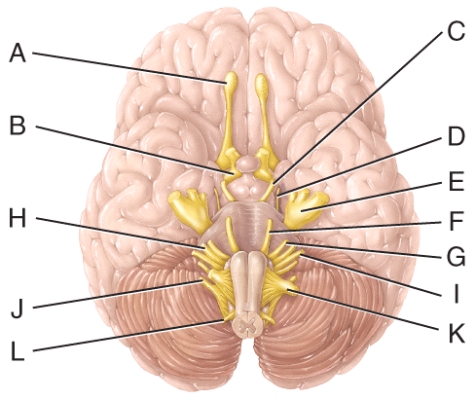
A)F
B)I
C)J
D)K
E)L

A)F
B)I
C)J
D)K
E)L

Unlock Deck
Unlock for access to all 75 flashcards in this deck.
Unlock Deck
k this deck
44
The maxillary branch of this labeled cranial nerve is found in the area where dentists apply anesthetic drugs for numbing the upper jaw.

A)E
B)G
C)H
D)I
E)J

A)E
B)G
C)H
D)I
E)J

Unlock Deck
Unlock for access to all 75 flashcards in this deck.
Unlock Deck
k this deck
45
Which cranial nerve in the diagram has a somatic motor function primarily involved in chewing?
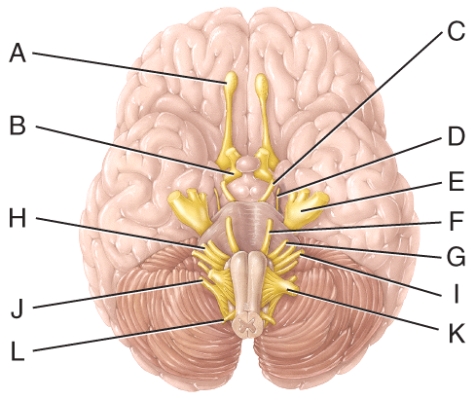
A)E
B)G
C)H
D)I
E)J

A)E
B)G
C)H
D)I
E)J

Unlock Deck
Unlock for access to all 75 flashcards in this deck.
Unlock Deck
k this deck
46
Which cranial nerve in the diagram is primarily involved in the sense of vision?
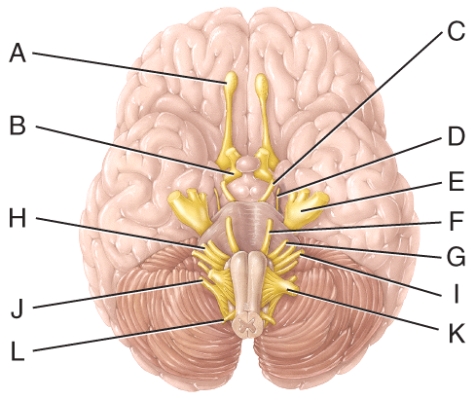
A)A
B)B
C)C
D)D
E)E

A)A
B)B
C)C
D)D
E)E

Unlock Deck
Unlock for access to all 75 flashcards in this deck.
Unlock Deck
k this deck
47
Damage to which cranial nerve in the diagram will cause the inability of an eyeball to move laterally beyond the midpoint?
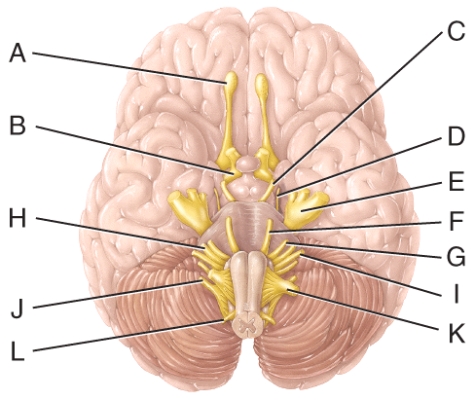
A)B
B)C
C)D
D)E
E)F

A)B
B)C
C)D
D)E
E)F

Unlock Deck
Unlock for access to all 75 flashcards in this deck.
Unlock Deck
k this deck
48
Damage to which cranial nerve in the diagram by shingles or Lyme disease produces Bell's palsy?
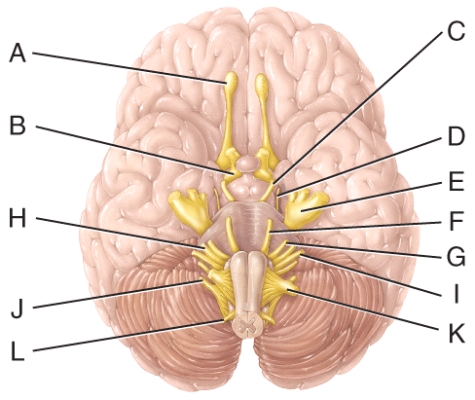
A)F
B)G
C)H
D)I
E)L

A)F
B)G
C)H
D)I
E)L

Unlock Deck
Unlock for access to all 75 flashcards in this deck.
Unlock Deck
k this deck
49
Which of the labeled structures in the diagram contains centers that control heart rate and blood pressure?
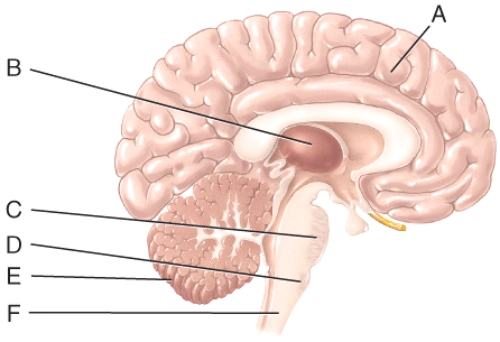
A)A
B)B
C)D
D)E
E)F

A)A
B)B
C)D
D)E
E)F

Unlock Deck
Unlock for access to all 75 flashcards in this deck.
Unlock Deck
k this deck
50
Which cranial nerve in the diagram is involved with speech and swallowing and has a purely motor function?
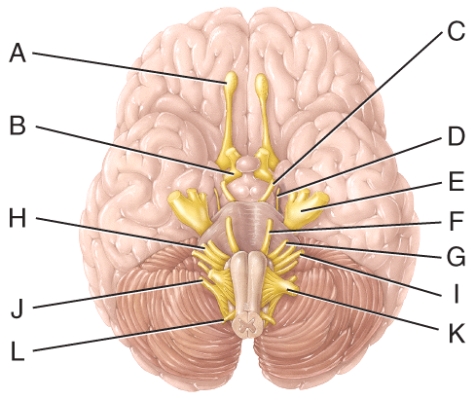
A)H
B)I
C)J
D)K
E)L

A)H
B)I
C)J
D)K
E)L

Unlock Deck
Unlock for access to all 75 flashcards in this deck.
Unlock Deck
k this deck
51
In 1848,a railroad worker named Phineas Gage was seriously injured during an explosion on the job.A tapered metal rod ranging from 0.25 inches to 1.25 inches in diameter and over 3 feet long entered his skull just under his left cheek bone and exited through the top of his skull.The rod was found over twenty feet away.Amazingly,Gage lived even though he suffered massive damage to the left front of his brain.His personality and intellectual abilities changed,however.Before the accident,he was respected as a smart,capable and even-tempered man.After the accident,he was foul-mouthed and bad-tempered and could not make up his mind.In the years immediately preceding his death,he began to have epileptic seizures.Explain the changes observed in Mr.Gage based on your knowledge of the brain.

Unlock Deck
Unlock for access to all 75 flashcards in this deck.
Unlock Deck
k this deck
52
Damage to which of the cranial nerves in the diagram would result in strabismus?

A)A
B)B
C)C
D)E
E)G

A)A
B)B
C)C
D)E
E)G

Unlock Deck
Unlock for access to all 75 flashcards in this deck.
Unlock Deck
k this deck
53
This major portion of the brain is used to monitor movements initiated by the motor areas of the cerebrum.
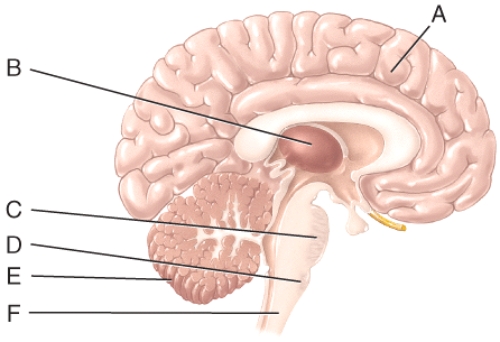
A)B
B)E
C)F
D)C
E)A

A)B
B)E
C)F
D)C
E)A

Unlock Deck
Unlock for access to all 75 flashcards in this deck.
Unlock Deck
k this deck
54
Which cranial nerve in the diagram has a somatic motor function primarily involved in moving the upper eyelid and eyeball?
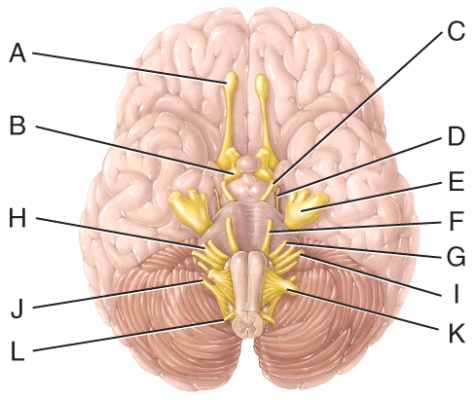
A)A
B)B
C)C
D)D
E)F

A)A
B)B
C)C
D)D
E)F

Unlock Deck
Unlock for access to all 75 flashcards in this deck.
Unlock Deck
k this deck
55
Which cranial nerve in the diagram has an autonomic motor function primarily involved in the secretion of saliva and tears?
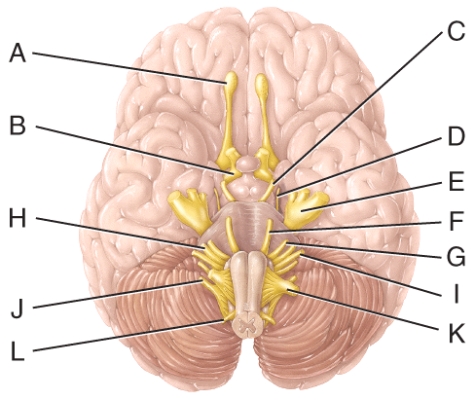
A)B
B)C
C)D
D)F
E)G

A)B
B)C
C)D
D)F
E)G

Unlock Deck
Unlock for access to all 75 flashcards in this deck.
Unlock Deck
k this deck
56
Which cranial nerve in the diagram has an autonomic motor function primarily involved in near vision accommodation and constriction of the pupil?
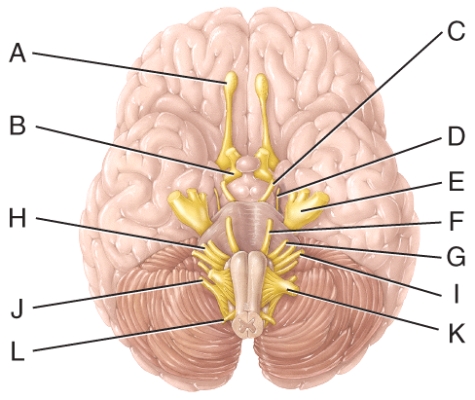
A)A
B)B
C)C
D)D
E)F

A)A
B)B
C)C
D)D
E)F

Unlock Deck
Unlock for access to all 75 flashcards in this deck.
Unlock Deck
k this deck
57
Which of the labeled structures in the diagram is the thalamus?

A)A
B)B
C)C
D)D
E)E

A)A
B)B
C)C
D)D
E)E

Unlock Deck
Unlock for access to all 75 flashcards in this deck.
Unlock Deck
k this deck
58
Which of the following cranial nerves is primarily responsible for changing facial expressions?
A)Oculomotor
B)Trigeminal
C)Spinal accessory
D)Facial
E)Vagus
A)Oculomotor
B)Trigeminal
C)Spinal accessory
D)Facial
E)Vagus

Unlock Deck
Unlock for access to all 75 flashcards in this deck.
Unlock Deck
k this deck
59
Anosmia may result from head injuries in which the cribriform plate of the ethmoid bone is fractured.This condition results in impaired function of which cranial nerve in the diagram?
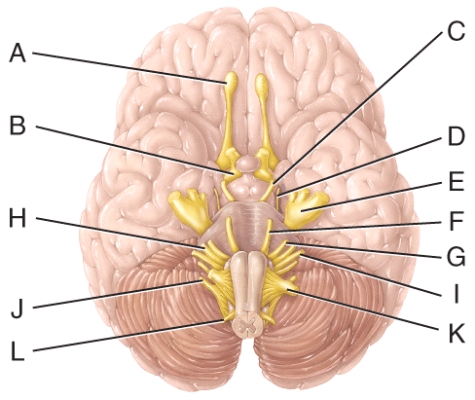
A)A
B)B
C)C
D)D
E)E

A)A
B)B
C)C
D)D
E)E

Unlock Deck
Unlock for access to all 75 flashcards in this deck.
Unlock Deck
k this deck
60
Describe the structural and functional relationship between the hypothalamus and the pituitary gland.

Unlock Deck
Unlock for access to all 75 flashcards in this deck.
Unlock Deck
k this deck
61
Hand preference when writing or throwing is an example of
A)cranial nerve damage.
B)hemispheric lateralization.
C)damage to the olfactory nerve.
D)damage to the Broca's area.
E)None of these choices.
A)cranial nerve damage.
B)hemispheric lateralization.
C)damage to the olfactory nerve.
D)damage to the Broca's area.
E)None of these choices.

Unlock Deck
Unlock for access to all 75 flashcards in this deck.
Unlock Deck
k this deck
62
A common type of disabling senile dementia that affects about 11% of the population over 65 and results in loss of reasoning and ability to care for oneself,is called
A)agnosia.
B)prosopagnosia.
C)Alzheimer disease.
D)transient ischemic attack syndrome.
E)amylotrophic lateral sclerosis.
A)agnosia.
B)prosopagnosia.
C)Alzheimer disease.
D)transient ischemic attack syndrome.
E)amylotrophic lateral sclerosis.

Unlock Deck
Unlock for access to all 75 flashcards in this deck.
Unlock Deck
k this deck
63
Which of the following types of tracts are used to conduct nerve impulses between gyri within the same cerebral hemisphere?
A)Association tracts
B)Commissural tracts
C)Projection tracts
D)Mammillothalamic tracts
E)Stria medullaris
A)Association tracts
B)Commissural tracts
C)Projection tracts
D)Mammillothalamic tracts
E)Stria medullaris

Unlock Deck
Unlock for access to all 75 flashcards in this deck.
Unlock Deck
k this deck
64
Which of the following statements best describes the structure of the blood-brain barrier that provides its functional characteristics?
A)Processes of astrocytes wrap tightly around capillaries in the brain.
B)Tight junctions tightly seal endothelial cells of capillaries in the brain.
C)Gap junctions tightly seal endothelial cells of capillaries in the brain.
D)Spot desmosomes tightly link capillary endothelial cells together.
E)The basement membrane of capillaries in the brain contains extremely small pores.
A)Processes of astrocytes wrap tightly around capillaries in the brain.
B)Tight junctions tightly seal endothelial cells of capillaries in the brain.
C)Gap junctions tightly seal endothelial cells of capillaries in the brain.
D)Spot desmosomes tightly link capillary endothelial cells together.
E)The basement membrane of capillaries in the brain contains extremely small pores.

Unlock Deck
Unlock for access to all 75 flashcards in this deck.
Unlock Deck
k this deck
65
The central sulcus of the cerebrum separates the
A)two cerebral hemispheres.
B)frontal lobe from the parietal lobe.
C)frontal lobe from the temporal lobe.
D)parietal lobe from the temporal lobe.
E)temporal lobe from the occipital lobe.
A)two cerebral hemispheres.
B)frontal lobe from the parietal lobe.
C)frontal lobe from the temporal lobe.
D)parietal lobe from the temporal lobe.
E)temporal lobe from the occipital lobe.

Unlock Deck
Unlock for access to all 75 flashcards in this deck.
Unlock Deck
k this deck
66
Damage to which portion of the limbic system results in loss of memory of recent events and difficulty committing anything new to memory?
A)amygdala
B)dentate gyrus
C)cingulate gyrus
D)hippocampus
E)septal nuclei
A)amygdala
B)dentate gyrus
C)cingulate gyrus
D)hippocampus
E)septal nuclei

Unlock Deck
Unlock for access to all 75 flashcards in this deck.
Unlock Deck
k this deck
67
Which lobe of the cerebrum is found deep to the other four lobes and thus cannot be observed from the surface?
A)occipital lobe
B)temporal lobe
C)parietal lobe
D)insula
E)corpus callosum
A)occipital lobe
B)temporal lobe
C)parietal lobe
D)insula
E)corpus callosum

Unlock Deck
Unlock for access to all 75 flashcards in this deck.
Unlock Deck
k this deck
68
An electroencephalogram (EEG)measures brain waves primarily generated by
A)neurons in the pons.
B)neurons in the medulla oblongata.
C)neurons in the thalamus.
D)neurons in the cerebral cortex.
E)neurons in the cerebellum.
A)neurons in the pons.
B)neurons in the medulla oblongata.
C)neurons in the thalamus.
D)neurons in the cerebral cortex.
E)neurons in the cerebellum.

Unlock Deck
Unlock for access to all 75 flashcards in this deck.
Unlock Deck
k this deck
69
A deep indentation found along the medial plane that separates the right and left cerebral hemispheres is called the
A)septum pellucidum.
B)transverse fissure.
C)tentorium cerebelli.
D)corpus callosum.
E)longitudinal fissure.
A)septum pellucidum.
B)transverse fissure.
C)tentorium cerebelli.
D)corpus callosum.
E)longitudinal fissure.

Unlock Deck
Unlock for access to all 75 flashcards in this deck.
Unlock Deck
k this deck
70
Patients with damage in the left hemisphere often exhibit aphasia (inability to use or comprehend words).This is an example of
A)apraxia.
B)delirium.
C)cerebral lacerations.
D)hemispheric lateralization.
E)decussations.
A)apraxia.
B)delirium.
C)cerebral lacerations.
D)hemispheric lateralization.
E)decussations.

Unlock Deck
Unlock for access to all 75 flashcards in this deck.
Unlock Deck
k this deck
71
Blood flows to the brain through the _____ arteries and away from the brain through the _____ vein.
A)internal carotid and vertebral;internal jugular
B)external carotid and vertebral;external jugular
C)internal jugular and vertebral;internal carotid
D)internal carotid and axillary;internal jugular
E)external jugular and axillary;external jugular
A)internal carotid and vertebral;internal jugular
B)external carotid and vertebral;external jugular
C)internal jugular and vertebral;internal carotid
D)internal carotid and axillary;internal jugular
E)external jugular and axillary;external jugular

Unlock Deck
Unlock for access to all 75 flashcards in this deck.
Unlock Deck
k this deck
72
This type of brain wave occurs at regular intervals when a person is awake but not when a person is sleeping.
A)Alpha waves
B)Beta waves
C)Theta waves
D)Delta waves.
E)All of the selections are correct
A)Alpha waves
B)Beta waves
C)Theta waves
D)Delta waves.
E)All of the selections are correct

Unlock Deck
Unlock for access to all 75 flashcards in this deck.
Unlock Deck
k this deck
73
Brain waves that appear during deep sleep are called
A)alpha waves.
B)beta waves.
C)theta waves.
D)delta waves.
E)P waves.
A)alpha waves.
B)beta waves.
C)theta waves.
D)delta waves.
E)P waves.

Unlock Deck
Unlock for access to all 75 flashcards in this deck.
Unlock Deck
k this deck
74
Brain waves that generally appear during periods of sensory input and mental activity are called
A)alpha waves.
B)beta waves.
C)theta waves.
D)delta waves.
E)P waves.
A)alpha waves.
B)beta waves.
C)theta waves.
D)delta waves.
E)P waves.

Unlock Deck
Unlock for access to all 75 flashcards in this deck.
Unlock Deck
k this deck
75
Which three areas of gray matter found in each cerebral hemisphere are important in helping to control the initiation and termination of skeletal muscle movements?
A)red nuclei
B)vestibular nuclei
C)lateral olivary nuclei
D)basal nuclei
E)autonomic ganglia
A)red nuclei
B)vestibular nuclei
C)lateral olivary nuclei
D)basal nuclei
E)autonomic ganglia

Unlock Deck
Unlock for access to all 75 flashcards in this deck.
Unlock Deck
k this deck



